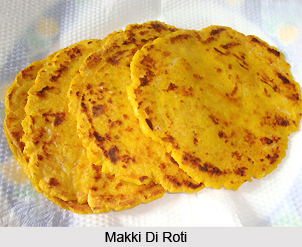 Makki di roti is a type of bread usually eaten in North India and Punjab province of Pakistan. This roti is primarily made form corn flour and just like most rotis in Indian cuisine, it is baked on a tava.
Makki di roti is a type of bread usually eaten in North India and Punjab province of Pakistan. This roti is primarily made form corn flour and just like most rotis in Indian cuisine, it is baked on a tava.
The literal meaning of `Makki di roti` in the Punjabi language is "bread of corn". This roti is flat in shape and yellow in colour when ready. Handling Makki di roti is quite tough as it has much less adhesive strength. Preparation of this roti is not time consuming but it requires patience.
Ingredients of Makki Di Roti (Serving: 5-6 people)
•2 cups maize flour
•1 fistful plain flour
•1 tbsp. Oil
•Salt to taste
•Water to knead
Method of Preparing Makki Di Roti
•Mix maize flour, oil and salt.
•Knead in soft pliable dough, adding very little water at a time.
•When the dough is very smooth and soft, bread a lump.
•Shape into a ball, flatten and pat with palm, to make a thin roti.
•Use dry plain flour to help. Or roll with a rolling pin.
•Take care to dust with flour and lift and turn to avoid sticking.
•Place on a heavy iron or earthen griddle and roast till crisp.
•Repeat on both sides. Repeat for all rotis.
•Cover and line with napkins to keep warm.
•Drizzle with ghee or butter if desired.
•Serve hot.
Makki Di Roti can also be made using chopped cilantro/ Coriander leaves to bring little variation in the preparation and taste.
Ingredients of Makki Di Roti (Serving 4 people)
•3 cups Maize
•1-2 green chillies, sliced thinly (or as per taste)
•Salt to taste
•Hot water to knead the dough
•Few sprigs of chopped cilantro/Coriander leaves
Method of Preparing Makki Di Roti
•Mix all the dry ingredients together.
•Make a hole in the middle and pour hot boiling water to it. Mix it lightly with a spatula. Let it sit for few minutes.
•Knead it well until smooth.
•Divide the dough into small balls. Place it on a lightly greased zip lock bag or any plastic sheet.
•Flatten it slightly with palm.
•Now place another plastic sheet on top of the flattened dough and slowly pat it down to flatten it further.
•Remove the top plastic sheet. Now very slowly transfer the pancake on to the palm. Be careful since the dough can break easily at this point.
•Now drop this on to a hot pan and drizzle some ghee all around it.
Turn it on the other side after about 3-4 minutes of cooking or when it turn a deeper shade of yellow and brown red spots.
•Serve hot topped with some butter.
Makki Di Roti is generally popular during the winter season in Punjab when there is abundant growth of the mustard leaves. It can be tasted by pairing up with sarson da saag (cooked mustard green leaves) or spinach as per choice.




















